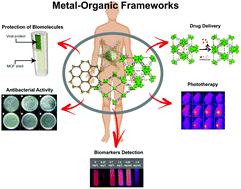当前位置:
X-MOL 学术
›
Chem. Soc. Rev.
›
论文详情
Our official English website, www.x-mol.net, welcomes your
feedback! (Note: you will need to create a separate account there.)
Metal–organic frameworks: a future toolbox for biomedicine?
Chemical Society Reviews ( IF 40.4 ) Pub Date : 2020-11-02 , DOI: 10.1039/d0cs00883d Ricardo F. Mendes 1, 2, 3, 4, 5 , Flávio Figueira 1, 2, 3, 4, 5 , José P. Leite 5, 6, 7, 8, 9 , Luís Gales 5, 6, 7, 8, 9 , Filipe A. Almeida Paz 1, 2, 3, 4, 5
Chemical Society Reviews ( IF 40.4 ) Pub Date : 2020-11-02 , DOI: 10.1039/d0cs00883d Ricardo F. Mendes 1, 2, 3, 4, 5 , Flávio Figueira 1, 2, 3, 4, 5 , José P. Leite 5, 6, 7, 8, 9 , Luís Gales 5, 6, 7, 8, 9 , Filipe A. Almeida Paz 1, 2, 3, 4, 5
Affiliation

|
The present review focuses on the use of Metal–Organic Frameworks, (MOFs) highlighting the most recent developments in the biological field. This review assesses, in the first instance, the cytotoxicity of MOFs (particularly those used for various biological applications described throughout this review), and shows that for standard MOFs based on metals already present in active molecules of the human body, toxicity is not a significant limitation. Here we underline the MIL-, UiO- and ZIF-series of MOFs which remain until now the most used materials in drug delivery of active pharmaceutical ingredients (APIs), such as antitumourals or retroviral drugs (with high loading and slow release time). Porosity remains undoubtedly the most studied key property of MOFs, that allows the protection of active biomolecules such as enzymes or the development of antimicrobial materials. Emphasis is given on the usage of MOFs for the detection of biomarkers in biological fluids such as urine and blood (detection of cystinuria, identification of penicillin anaphylaxis, urea, bilirubin, biomarkers related to human intoxication, tumoural indicators, among several others), for which a number of simple devices (such as paper strips) were developed. Despite the remarkable and promising results presented in recent years, the literature remains scarce (mostly non-existent) in terms of direct comparison of these novel technologies with the solutions presently available in the market. Action on this side may make the difference in the next years concerning research on MOFs, to see if some of these materials may reach the end-user as new and more efficient treatments or detection approaches.
中文翻译:

金属有机框架:生物医学的未来工具箱?
本综述着重于金属有机框架(MOF)的使用,重点介绍了生物领域的最新进展。这篇综述首先评估了MOF的细胞毒性(尤其是贯穿本综述描述的用于各种生物学应用的那些),并表明对于基于已经存在于人体活性分子中的金属的标准MOF,其毒性不是重大限制。在这里,我们强调了MOF的MIL系列,UiO系列和ZIF系列,直到现在,MOF仍是活性药物成分(API)药物递送中使用最多的材料,例如抗肿瘤药或逆转录病毒药物(高载量和缓慢释放时间)。毫无疑问,孔隙率仍然是MOF的最主要研究属性,可以保护活性生物分子(例如酶)或开发抗菌材料。重点介绍了使用MOF来检测尿液和血液等生物体液中的生物标志物(检测胱氨酸尿症,识别青霉素过敏,尿素,胆红素,与人体中毒有关的生物标志物,肿瘤指标等),开发了许多简单的设备(例如纸带)。尽管近年来出现了令人瞩目的令人鼓舞的结果,但就这些新颖技术与市场上现有解决方案的直接比较而言,文献仍然很少(几乎不存在)。在未来几年,有关MOF的研究可能会有所作为,
更新日期:2020-11-03
中文翻译:

金属有机框架:生物医学的未来工具箱?
本综述着重于金属有机框架(MOF)的使用,重点介绍了生物领域的最新进展。这篇综述首先评估了MOF的细胞毒性(尤其是贯穿本综述描述的用于各种生物学应用的那些),并表明对于基于已经存在于人体活性分子中的金属的标准MOF,其毒性不是重大限制。在这里,我们强调了MOF的MIL系列,UiO系列和ZIF系列,直到现在,MOF仍是活性药物成分(API)药物递送中使用最多的材料,例如抗肿瘤药或逆转录病毒药物(高载量和缓慢释放时间)。毫无疑问,孔隙率仍然是MOF的最主要研究属性,可以保护活性生物分子(例如酶)或开发抗菌材料。重点介绍了使用MOF来检测尿液和血液等生物体液中的生物标志物(检测胱氨酸尿症,识别青霉素过敏,尿素,胆红素,与人体中毒有关的生物标志物,肿瘤指标等),开发了许多简单的设备(例如纸带)。尽管近年来出现了令人瞩目的令人鼓舞的结果,但就这些新颖技术与市场上现有解决方案的直接比较而言,文献仍然很少(几乎不存在)。在未来几年,有关MOF的研究可能会有所作为,











































 京公网安备 11010802027423号
京公网安备 11010802027423号